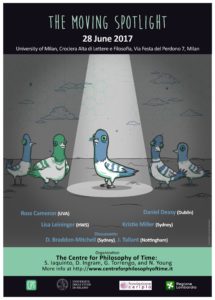The Moving Spotlight
University of Milan, Sala Crociera Alta, Via Festa del Perdono 7, Milan
–
Speakers
Ross Cameron (Virginia)
Daniel Deasy (Dublin)
Lisa Leininger (HWS)
Kristie Miller (Sydney)
—
David Braddon-Mitchell (Sydney)
Jonathan Tallant (Nottingham)
–
Programme
09.45. Welcome
10.00–11.30. Daniel Deasy – “Moving Spotlight Theories”
11.45–13.15. Kristie Miller – “Moving Spotlight or Cresting Wave? A New Moving Spotlight Theory”
13.15. Lunch
14.30–16.00. Lisa Leininger – “The Moving Spotlight’s Broken Lightbulb”
16.00. Coffee
16.30–18.00. Ross Cameron – “Passage in the Moving Spotlight”
18.30. Aperitivo
20.30. Dinner
—
Abstracts
Ross Cameron: Passage in the Moving Spotlight
What does it take for time to pass? Here are two extreme answers: It is sufficient for time to pass that things be different from one time to another, and so even the B-theory allows for the passage of time. It is necessary for time to pass that there be a dimension of hypertime, through which our entire history changes. I will argue that both extreme answers are false. There is no genuine passage on the B-theory, but the A-theorist does not need hypertime to secure the passage of time. I will present a version of the Moving Spotlight view that accounts for genuine passage, and argue that it is superior to rival accounts of passage defended by Kit Fine and Bradford Skow.
–
Daniel Deasy: Moving Spotlight Theories
The moving spotlight theory of time combines the theses of ontological eternalism (according to which everything exists eternally) and propositional temporalism (according to which some propositions are sometimes true and sometimes false). In recent years there has been an explosion of interest in the view. In this paper I consider four recent versions of the theory due to Williamson (2002), Cameron (2015), Deasy (2015) and Skow (2015). In particular, I consider how best to characterise the differences between these different versions of the theory, and describe some of the problems and prospects for each.
–
Lisa Leininger: The Moving Spotlight’s Broken Lightbulb
The Moving Spotlight theory of time (MST) is commonly understood to combine elements of eternalism (that the past, present, and future are ontologically on par) and A-theory (that there is a privileged present) in which a “spotlight” sweeps through the four-dimensional manifold; each moment is “lit up” in turn as the objectively privileged present. In MST, the passage of time is then formulated as a change in what moment is objectively privileged as the present. I argue that the proponent of MST must account for a moment being formerly objectively privileged for there to be a change in what moment is objectively privileged. But any way the proponent of MST accounts for this (including appeal to a supertime or appeal to temporal distributional properties) results in more than one moment being present simpliciter. Ultimately, the proponent of MST must admit that all moments are present simpliciter, which really means that there is no one objectively privileged present moment. The moving spotlight’s lightbulb, it turns out, does not shine on anything.
–
Kristie Miller: Moving Spotlight or Cresting Wave? A New Moving Spotlight Theory
One argument for the moving spotlight theory is that it better explains our temporal phenomenology than does any static theory of time. Call this the argument from temporal phenomenology. In this paper it is argued that insofar as moving spotlight theorists take this to be a sound argument, they ought embrace a new version of the moving spotlight theory. On such a theory the moving spotlight is replaced by a cresting wave of causal efficacy. That wave causes (inter alia) our temporal phenomenology to have a certain phenomenal character: namely, causes it to seem to us as though time passes. This phenomenal character co-varies with the presence of presentness in that the phenomenal character of our experiences at times that are not present is not as of time passing. That’s because the wave of causal efficacy changes the qualitative properties of each time it reaches. Not only are the qualitative properties of a time when that time is future, different from its qualitative properties when it is present, but so too that time’s qualitative properties when it is past are different from its qualitative properties when it is present.
–
Organisers: S. Iaquinto, D. Ingram, G. Torrengo, and N. Young
